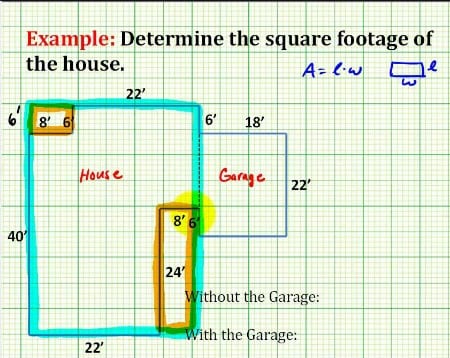Aug 18, 2016 / Selling
Home Evaluations – Calculating Your Home’s Square Footage

A home’s square footage is one of the factors a real estate agent takes in to account when completing a home evaluation. And if all houses were single-story square shaped buildings, calculating the square footage of your home would be a simple matter.
Your home’s square footage is relied on to estimate a home’s value, cost to construct and overall livability. So it is worth understanding exactly what square footage means and how it is calculated.
Matt Clawson, Houzz contributor, recently posted this great article: How to Calculate a Home’s Square Footage ‘Understanding your home’s square footage requires more than just geometry’.
We have edited it down and added our comments. To dig deeper, check out Matt’s original article along with the wonderful diagrams and photos he included.
_______________________
All square feet are not created equal.
There are basements, attics, garages remodeled into living spaces, and oversized storage rooms with poorly accessible corners.
However, for the most part, calculating square footage, is all about rectangles, with the help of a few formulas.
Calculations for the square footage of a home are taken from the outside dimensions of the structure (so exterior and interior wall thickness is included).
If your home exterior is easily accessible, you can do it yourself. By now, there’s probably an app or 3D technology that can do it for you, otherwise a 100-foot tape measure will do.
Walk around the exterior measuring each segment and drawing the shape as you go. If, like most homes, your exterior has a series of square corners, you will be able to take measurements easily at the foundation, rounding measurements to the nearest half foot and sketching the exterior shape of your home.
If there are overhangs or slopes making exterior measurements difficult, measure from the inside, and add the width of each exterior wall (likely half a foot, but you can check at the door jamb of an exterior wall).
The next step is to sit down with that paper and break the shape into a series of rectangles. (There are plenty of instructional videos available online if you’d like a hands-on lesson.) Then it’s a  matter of using simple (relatively speaking) math: Width x Length = Area
matter of using simple (relatively speaking) math: Width x Length = Area
You might find a triangle or two (Area = 0.5 x Base x Height). For example, a bay window with a pair of angled walls might (geometrically) be a pair of triangles with a rectangle in the middle.
Add up the spaces of each of your rectangles and triangles, and subtract any areas that should not be included in overall square footage (for instance, partially enclosed patios or exterior storage areas), and you arrive at the total area (square feet).
If Only It Were That Simple.
Angled walls are only the beginning of your problems. Some additional, generally accepted rules follow:
- Below grade, basements are generally not included. They are often noted separately.
- Attic areas are counted if conditioned in the same manner as the rest of your home, accessible from livable space and with ceilings that are at least 84 inches high.
- Stairs are included.
- Garages and other nonconditioned spaces are not included. Some garages have been converted into habitable spaces and are included in the square footage calculations.
- Condominium square footage is typically calculated using interior dimensions.
- When calculating the square footage of homes with second stories, second floor measurements sometimes need to be taken from the interior, investigating the overall shape of the second floor as it pertains to the first. The exterior wall thickness is then added and included in the overall square footage.
- Storage rooms are included in square footage calculations if the room is conditioned in a similar manner to the rest of the home and is accessible from living space in the home.
The professional tradespeople who did your home improvement renovations use the same formula (WXL=Area) to calculate square footage. However, those calculations are task specific and maybe not be accurate enough for your purposes.
If you feel you are up to the challenge yourself, break out the 100-foot tape measure and get to work. Simple structures are pretty straightforward. In complicated homes, you may want to save yourself the headache and ask a professional.
Want to know your home’s square footage? I’d love help out and complete home evaluation at the same time. I’ll even bring my own 100′ tape measuring tape.
Our team of real estate sales professionals is committed to finding you, your dream home. Whether you’re looking to buy or sell, the Karen Paul team is here to help with any questions.
Interested in learning more? Send us a message here and we’ll be in touch with you soon after.

